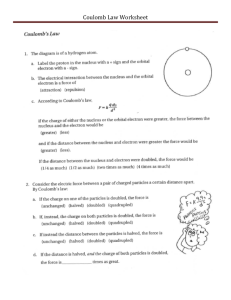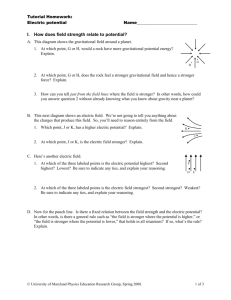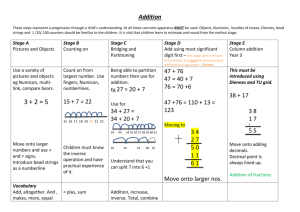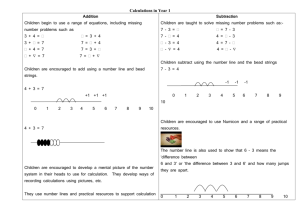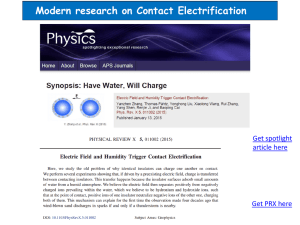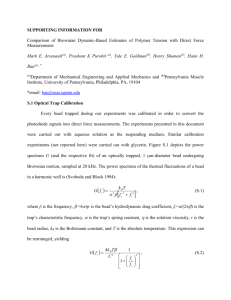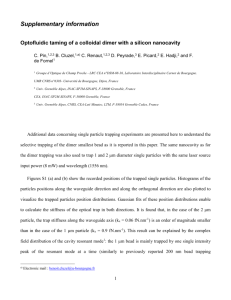I. Potential energy in a field
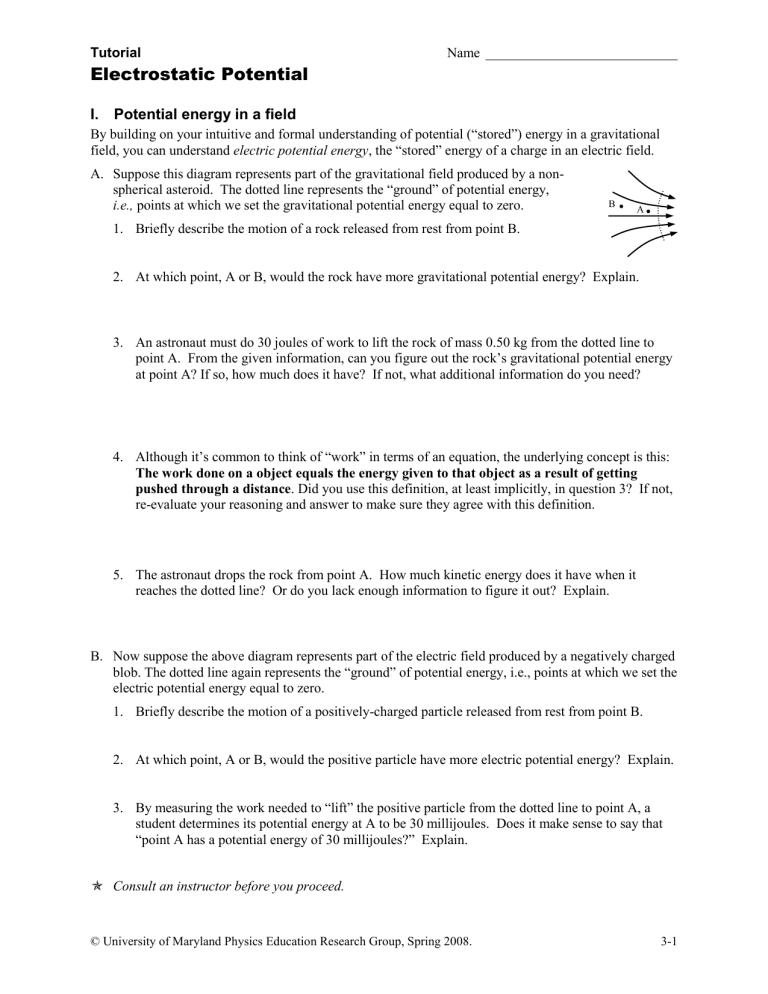
Tutorial
Electrostatic Potential
Name
I. Potential energy in a field
By building on your intuitive and formal understanding of potential (“stored”) energy in a gravitational field, you can understand electric potential energy
, the “stored” energy of a charge in an electric field.
A.
Suppose this diagram represents part of the gravitational field produced by a nonspherical asteroid. The dotted line represents the “ground” of potential energy, i.e., points at which we set the gravitational potential energy equal to zero.
1.
Briefly describe the motion of a rock released from rest from point B.
B
A
2.
At which point, A or B, would the rock have more gravitational potential energy? Explain.
3.
An astronaut must do 30 joules of work to lift the rock of mass 0.50 kg from the dotted line to point A. From the given information, can you figure out the rock’s gravitational potential energy at point A? If so, how much does it have? If not, what additional information do you need?
4.
Although it’s common to think of “work” in terms of an equation, the underlying concept is this:
The work done on a object equals the energy given to that object as a result of getting pushed through a distance . Did you use this definition, at least implicitly, in question 3? If not, re-evaluate your reasoning and answer to make sure they agree with this definition.
5.
The astronaut drops the rock from point A. How much kinetic energy does it have when it reaches the dotted line? Or do you lack enough information to figure it out? Explain.
B.
Now suppose the above diagram represents part of the electric field produced by a negatively charged blob. The dotted line again represents the “ground” of potential energy, i.e., points at which we set the electric potential energy equal to zero.
1.
Briefly describe the motion of a positively-charged particle released from rest from point B.
2.
At which point, A or B, would the positive particle have more electric potential energy? Explain.
3.
By measuring the work needed to “lift” the positive particle from the dotted line to point A, a student determines its potential energy at A to be 30 millijoules. Does it make sense to say that
“point A has a potential energy of 30 millijoules?” Explain.
Consult an instructor before you proceed.
© University of Maryland Physics Education Research Group, Spring 2008. 3-1
Tutorial: Electrostatic potential
C.
This diagram shows a new, uniform electric field.
1.
At which of the three labeled points would a +1 coulomb charge have the most electric potential energy? The second most electric potential energy? The least?
( Hint: Think about whether a particle must “rise against” the field or “fall” with the field to get from one point to another. Does “falling” correspond to gaining or losing potential energy?)
F
D E
2.
Now we’ll help you check your answer. Imagine the +1 coulomb charge moving from D to F.
Does the charge naturally “fall” through that distance, or must you “lift” it from D to F?
3.
So, does the charge gain or lose electric potential energy going from D to F? Does this agree with your reasoning in question 1 above?
4.
Now imagine the +1 coulomb charge moving from D to E. Does it “fall,” does it get “lifted,” or something else?
5.
So, going from D to E, does the charge gain potential energy, lose potential energy, or neither?
Does this agree with your reasoning in question 1 above?
Consult an instructor before you proceed.
II. From potential energy to potential
Again consider the electric field from the previous page, redrawn here. A student determines the potential energy of various charged beads at point A by measuring how much work it takes to “lift” each bead from the dotted line to point A.
B
A
A.
The work done on a 2.0 coulomb bead, and hence its electric potential energy at point A, was 20 joules. A new bead carries twice as much charge, 4.0 coulombs.
Intuitively, how much electric potential energy do you expect the new bead to have at point A? Why?
B.
Same question, different bead: How much work does it take, and therefore how much potential energy is given to a 5.0 coulomb bead moved from the dotted line to point A?
C.
Suppose you want to use a single number to best express potential-energy information about point A, a number that applies to the 2.0 coulomb bead, the 4.0 coulomb bead, the 5.0 coulomb bead, and any other bead at point A — even though those different beads all have different potential energies) To be useful, the number should make it easy to calculate the electric potential energy of any charge at point A.
1.
What number would you choose?
2.
What are the units of that number?
© University of Maryland Physics Education Research Group, Spring 2008. 3-2
Tutorial: Electrostatic potential
The number you just came up with is called the electric potential , to distinguish it from electric potential energy . Electric potential is denoted V.
D.
Let U denote electric potential energy of a bead and q denote the charge of that bead. Generalizing the reasoning you just used, come up with an equation relating U , V , and q .
E.
We saw above that it makes no sense to say point A has an electric potential energy, because different beads at that point have different potential energies. Does it make sense to say point A has an electric potential? Explain.
F.
At which point, A or B, is the electric potential higher? Explain. (You already answered a similar question about the electric potential energy, but not about electric potential.)
Consult an instructor before you proceed.
III. Equipotential maps
So far in this tutorial, our diagrams have shown electric fields. To introduce diagrams of electric potential, we’ll start with an analogy…
A.
Suppose this diagram is a contour map of a hill, showing lines of equal height. For instance, the curvy line that includes points P and R consists of points 20 meters above sea level. The dashed lines show two paths by which a hiker can climb from P to a scenic view at S.
1.
A ball is placed on the ground at point P and released from rest. It starts rolling. On the map, draw an arrow showing its initial direction of motion. Do the same for a ball at point R. Explain.
2.
At which point, P or R, is the hill steeper? Articulate your reasoning, because you’ll build on it below.
P
40
S
30
20
10
R
3.
An equipotential line is a line (or curve) along which you could walk without gaining or losing potential energy. Are the lines of equal height also equipotential lines? Give an intuitive explanation; don’t just cite an equation.
4.
A backpack gets carried from P to S. Along which dashed path, if either, would it gain more gravitational potential energy: the direct path or the curvy path? Explain.
© University of Maryland Physics Education Research Group, Spring 2008. 3-3
Tutorial: Electrostatic potential
5.
Along which path, if either, is more work done on the backpack? Hint: Think about the relation between work and change in energy.
6.
The work is the same along either path, since all the work done on the backpack goes into increasing its gravitational potential energy, and the gain in gravitational potential energy is the same along either path. This path-independence of the work initially seems counterintuitive to most people. Can you make intuitive sense of this result? Hint: Think about which path is longer vs. which path is steeper (on average).
Consult an instructor before you proceed.
B.
Now suppose the diagram shows electric equipotential lines corresponding to an unpictured, irregularly-shaped charged blob — not a point charge! So, when a charged particle “walks” along one of those curves, it neither gains nor loses electric potential energy. For instance, point P and R both have potential V = 20 volts (joules per coulomb)
1.
A positively charged dust particle is released from rest from point
P. Draw an arrow showing its initial direction of motion. Do the same for a positive particle released from point R. Explain.
40
30
20
10
S
P
R
2.
Do the arrows you just drew also show the direction of the electric field at those points? Explain why or why not.
3.
At which point, P or R, is the electric field stronger? How do you know? Hint: Think of a rock falling in a strong gravitational field vs. a weak gravitational field. In which field must the rock fall farther to lose a given amount of potential energy? What conclusions can you reach about the relation between field strength and the spacing of equipotential lines?
4.
A tiny positively-charged bead gets carried from P to S. Along which path, if either, would it gain more electric potential energy: the direct path or the curvy path? Explain.
5.
Along which path, if either, is more work done on the bead? Can you make intuitive sense of this result?
© University of Maryland Physics Education Research Group, Spring 2008. 3-4
